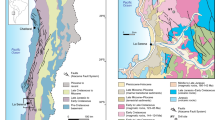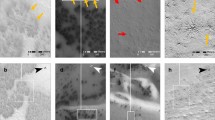Abstract
THE fragmentation of rocks by the crystallization of salts, for convenience termed ‘salt weathering’, is important in a restricted range of environments and produces distinctive topographic forms. Relatively hard rocks can be completely broken down into their component particles by soaking them in a salt solution and allowing the salt to crystallize in the interstices1. The chemical free energy of a given mass of solid increases with its surface area. Therefore any system tends to reduce the area of its interfaces to a minimum2, and in a system containing crystals in equilibrium with a saturated solution larger crystals will grow at the expense of the smaller. It is less obvious why, when the larger crystals entirely fill a pore space, they continue to grow against the constraint imposed by the walls of the pore, expand the pore and fragment the rock. The work required to be done during crystal growth on one face of a crystal (ref. 3) is equal to (Pl–Ps) dV, where Pl is the pressure in the liquid, Ps the pressure in the solid, and dV the increase in volume. This must equal the work done in extending the surface3, which is equal to σdA, where σ is the interfacial tension between the crystal face and its saturated solution and dA is the increment of volume. Then since σ is independent of V:  Consider crystallization in a porous solid with large pores and small pores both filled with the saturated salt solution; let water evaporate and escape from the system, or let crystallization be induced by a temperature change. First, the larger crystals in the large pores will grow at the expense of small crystals in the small pores. Let the process continue until salt crystals completely fill the large pores. Now since Ps–Pl = σ dA/dV for the crystal to grow down the capillary pores would greatly increase the area of the crystal, but only slightly increase its volume The crystal will therefore grow in the large pore until the pressure builds up to such an extent that either mechanical fracture occurs or (Ps–Pl)/σ becomes greater than the necessary dA/dV to make the crystal grow down the capillary pore. Thus (for a given crystal and therefore a given σ) whether or not fracture occurs depends on smallness of the small pores and the value of σ compared with the mechanical strength of the porous material. Hence a large rock pore will be enlarged provided that the surface tension of the salt times the dA/dV of the micro-pores is greater than the mechanical strength of the rock. Thus for rocks of equal mechanical strength those with large pores separated from each other by micro-porous regions will be the most liable to salt weathering.
Consider crystallization in a porous solid with large pores and small pores both filled with the saturated salt solution; let water evaporate and escape from the system, or let crystallization be induced by a temperature change. First, the larger crystals in the large pores will grow at the expense of small crystals in the small pores. Let the process continue until salt crystals completely fill the large pores. Now since Ps–Pl = σ dA/dV for the crystal to grow down the capillary pores would greatly increase the area of the crystal, but only slightly increase its volume The crystal will therefore grow in the large pore until the pressure builds up to such an extent that either mechanical fracture occurs or (Ps–Pl)/σ becomes greater than the necessary dA/dV to make the crystal grow down the capillary pore. Thus (for a given crystal and therefore a given σ) whether or not fracture occurs depends on smallness of the small pores and the value of σ compared with the mechanical strength of the porous material. Hence a large rock pore will be enlarged provided that the surface tension of the salt times the dA/dV of the micro-pores is greater than the mechanical strength of the rock. Thus for rocks of equal mechanical strength those with large pores separated from each other by micro-porous regions will be the most liable to salt weathering.
This is a preview of subscription content, access via your institution
Access options
Subscribe to this journal
Receive 51 print issues and online access
$199.00 per year
only $3.90 per issue
Buy this article
- Purchase on Springer Link
- Instant access to full article PDF
Prices may be subject to local taxes which are calculated during checkout
Similar content being viewed by others
References
Glaessner, M. F., Principles of Micropalaeontology, 37 (Melbourne Univ. Press, 1948).
Thomson, W., Proc. Roy. Soc., 9, 255 (1858); Phil. Mag. (4), 17, 61 (1859). Verhoogen, J., J. Geol., 56, 210 (1948).
Lewis, G. N., and Randall, M., Thermodynamics, second ed. (McGraw-Hill, N.Y., 1961).
Huxley, L., Scott's Last Expedition, 11 (Macmillan and Co., London, 1913).
Llano, G. A., Sci. American, 207, 225 (1962).
Jutson, J. T., Proc. Roy. Soc., Victoria, 30 (2), 165 (1918).
Taylor, G., The Physiography of the McMurdo Sound and Granite Harbour Region (Harrison, London, 1922).
Kelley, W. C., and Zumberge, J. H., J. Geol., 69, 433 (1961).
Gibson, G. W., N.Z.J. Geol. Geophys., 5, 361 (1962).
Ollier, C. D., and Tuddenham, W. G., Z. Geomorph., 4, 257 (1961).
Reed, J. J., N.Z.J. Sci. Tech., 28 (B), 249 (1947).
Howe, J. A., J. Roy. Inst. Brit. Arch., 37 (1), 16 (1929).
Cotton, C. A., Climatic Accidents (Whitcome and Tombs, Ltd., 1942).
Schaffer, R. J., D.S.I.R. London, Building Res. Spec. Rpt., 18 (1933).
Tricart, J., Cahiers Oceanogr. du C.O.E.C., 11, 276 (1959).
Author information
Authors and Affiliations
Rights and permissions
About this article
Cite this article
WELLMAN, H., WILSON, A. Salt Weathering, a Neglected Geological Erosive Agent in Coastal and Arid Environments. Nature 205, 1097–1098 (1965). https://doi.org/10.1038/2051097a0
Issue Date:
DOI: https://doi.org/10.1038/2051097a0
This article is cited by
-
Experimental study of sulfate crystallization damage to glutenite rock in the Maijishan Grottoes
Heritage Science (2024)
-
Effect of combined salt and temperature on heterogeneous Algerian stones durability
Environmental Earth Sciences (2023)
-
Key parameters of volcanic tuffs used as building stone: a statistical approach
Environmental Earth Sciences (2022)
-
A review of theoretical salt weathering studies for stone heritage
Progress in Earth and Planetary Science (2021)
-
Chemical weathering in Antarctica: an example of igneous rock particles in Big Lachman Lake sediments, James Ross Island
Environmental Earth Sciences (2020)
Comments
By submitting a comment you agree to abide by our Terms and Community Guidelines. If you find something abusive or that does not comply with our terms or guidelines please flag it as inappropriate.



